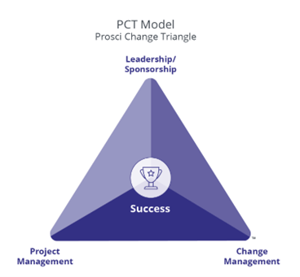In 2006, Prosci released a model to enable its change practitioners to take the pulse across a set of indicators to give a broad sense of whether an organisation was headed for success in each change project. At that time called the Project Change Triangle, the PCT Model quickly became one of the “most reached for” tools in the Prosci change practitioner’s toolkit; a simple and easy to understand scoring framework, which gave us practitioners a health check, or pulse check, on a change project with results utilising a familiar traffic-light red-amber-green output.
We found the PCT Model quick to use once we became accustomed to it. Having trained thousands of change practitioners, my experience was that the PCT Model, taught on day one of the three-day certification programme, was invariably the moment when student practitioners sat forward in their seats, began nodding their heads and taking lots of notes; I could see the PCT Model resonating with them.
Fast-forward 15 years, and as part of the enhancement to its methodology, Prosci augmented the PCT Model: we renamed the Model to the Prosci Change Triangle as a reflection that not all organisational changes are managed as projects and added a fourth aspect - success - to be evaluated alongside the original three aspects of leadership/sponsorship, project management and change management.
The success aspect focuses on areas including whether the organisational benefits of the change have been defined and whether units of measurement for benefits and objectives have been established. The PCT Model is now clearly positioned as one of the foundational models of the Prosci methodology. I still teach the PCT Model on day one of the Certification programme and whether across Zoom or Teams or as, post-Covid, I am now back in the same room, the PCT Model continues to grab programme attendees’ attention.

As I engage in my change practice advisory and coaching work with clients, one of the clear trends I have experienced over the years is, as outlined above, change practitioners invariably reach for the PCT Model to help them assess whether the organisation is heading towards success with a given change.
The pronoun in the final phrase of that sentence is telling: change practitioners deploy a PCT Model assessment to help them understand the organisational health of the change, but change practitioners often do not engage with sponsors, project managers, scrum masters, team leaders, in either completing the 40-factor assessment nor, more critically for me, in devising and assigning actions aimed at de-risking the chance of successful change outcomes.
Last year, Prosci conducted two live-webinars studies in which it asked nearly one hundred change practitioners how they were using the PCT Model assessment in their change practice. The complete findings of this deep-dive research are available in the Research Hub of Prosci’s Hub Suite (Prosci change practitioners, if you have let your Research Hub subscription lapse, now would be a great time to renew).
Findings that loudly chimed with my experience as a change adviser and coach are that collaborative, discussion based PCT assessments are nearly 2.5 times more effective than PCT assessments completed alone but almost a fifth of respondents to the research said they, as change practitioner, completed the assessment alone, without collaborating with any other key players. Exploration of this seeming incongruity took place in the live webinars with practitioners sharing how they apply the PCT Model in their work, including when and with whom they use PCT assessments.
If you would like to take the opportunity to take a deeper dive into the applications of the PCT Model, be sure not to miss out on our next virtual Practitioner Meet-Up with our in-house experts Imogen Parnham-Kenny and Morgan Campbell.
Register for free here

